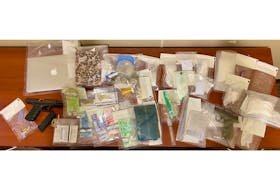
More than 200 cats have been trapped, neutered and returned to several locations in the Shiretown by the local chapter of CA-R-MA (Cat Rescue Maritimes). The colonies located there are now known as maintenance sites.
“Maintenance means all of the large colonies brought to our attention have been TNR’d,” said chairperson Helen Baudoux-McLaughlin.
CA-R-MA humanely traps feral cats, has them neutered or spayed, vaccinated and ear-tipped to show they’re fixed. They’re then returned to a monitored site where food, water and shelter is provided through caregivers. This is referred to as TNR.
Formed in 2011, CA-R-MA been working in the Shiretown since then to humanely reduce numbers and suffering in feral cat populations. “If done rigorously, it will make a huge effect,” said Baudoux-McLaughlin.
She said the number of feral kittens in Pictou was noticeably smaller last summer. “We’ve seen a decline from previous years – that’s how you know the program is working.”
CA-R-MA needs to have funds and volunteers in place to carry out its work, and has a list of communities from River John to Barneys River in need of help.
“It’s an urgent need for us,” she said. “We need that to be able to do the work we want to do, especially with expanding the work into the county and the other towns. It’s a huge endeavour.”
Trapping has to take place in a colony all in a single day, so a large number of volunteers are needed. “They’re all trapped in one day because the chances of getting them again after they’ve been scared are then slim,” she said. “It’s a big job that day.”
Volunteers can help in many ways – from helping with fundraising to transporting trapped cats to the veterinary clinic. People are also needed to foster kittens found when a colony is trapped.
If kittens under eight weeks old are found, they are placed with foster families to domesticate them. “We put them with a foster family to socialize them and get them used to human contact so we can adopt them out.”
Donations can include money, food, litter and carriers.
Volunteers with CA-R-MA are trying to get out to some of the new sites as early as possible, with trapping usually starting in April when it’s warmer outside. “We can’t shave a female’s belly… then put her out in the cold.”
The group is making presentations at local municipal council meetings to raise awareness and to ask for financial support, visiting Stellarton last week.
They’re hoping to secure some funding from the municipalities to start their work earlier this year. Last year CA-R-MA wasn’t able to begin TNR until late in June, and by this time, many of the females had already had kittens.
Because of the mild winter, Baudoux-McLaughlin expects that female cats may have up to three litters this year. “It makes it a crisis number for us.”
Due to funding from a memorial donation, the first site they will tackle is a colony of 23 cats in the Salt Springs area. But without funding, they won’t be able to help others.
With no intervention, two cats and their kittens can produce 420,000 cats over the course of seven years. “The biggest thing people need to know is the homeless cat population in the Maritimes is at a crisis proportion,” said Baudoux-McLaughlin.
Understanding CA-R-MA
A feral cat is not a wild animal like a bobcat or lynx. They are common domestic cats that have had little or no positive interaction with humans and can’t be handled.
Kittens born to these cats will grow up to be feral, but if cared for by humans at a young age, they can become companionable, ordinary household pets.
Adult feral cats are poor candidates for successful adoption into homes.
CA-R-MA is a program, and Baudoux-McLaughlin said many people misunderstand what the organization does. “We’re not a place, we’re not a shelter, we’re not animal control. We can’t take in unwanted pets or stray or abandoned animals.”
More information about CA-R-MA can be found at http://www.ca-r-ma.org.








